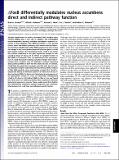∆FosB differentially modulates nucleus accumbens direct and indirect pathway function
Author(s)
Neve, Rachael L.; Grueter, Brad A.; Robison, Alfred J.; Nestler, Eric J.; Malenka, Robert C.
DownloadGrueter-2013-differentially modulates nucleus accumbens direct and indirect pathway function.pdf (953.8Kb)
PUBLISHER_POLICY
Publisher Policy
Article is made available in accordance with the publisher's policy and may be subject to US copyright law. Please refer to the publisher's site for terms of use.
Terms of use
Metadata
Show full item recordAbstract
Synaptic modifications in nucleus accumbens (NAc) medium spiny neurons (MSNs) play a key role in adaptive and pathological reward-dependent learning, including maladaptive responses involved in drug addiction. NAc MSNs participate in two parallel circuits, direct and indirect pathways that subserve distinct behavioral functions. Modification of NAc MSN synapses may occur in part via changes in the transcriptional potential of certain genes in a cell type–specific manner. The transcription factor ∆FosB is one of the key proteins implicated in the gene expression changes in NAc caused by drugs of abuse, yet its effects on synaptic function in NAc MSNs are unknown. Here, we demonstrate that overexpression of ∆FosB decreased excitatory synaptic strength and likely increased silent synapses onto D1 dopamine receptor–expressing direct pathway MSNs in both the NAc shell and core. In contrast, ∆FosB likely decreased silent synapses onto NAc shell, but not core, D2 dopamine receptor–expressing indirect pathway MSNs. Analysis of NAc MSN dendritic spine morphology revealed that ∆FosB increased the density of immature spines in D1 direct but not D2 indirect pathway MSNs. To determine the behavioral consequences of cell type-specific actions of ∆FosB, we selectively overexpressed ∆FosB in D1 direct or D2 indirect MSNs in NAc in vivo and found that direct (but not indirect) pathway MSN expression enhances behavioral responses to cocaine. These results reveal that ∆FosB in NAc differentially modulates synaptic properties and reward-related behaviors in a cell type- and subregion-specific fashion.
Date issued
2013-01Department
Massachusetts Institute of Technology. Department of Brain and Cognitive SciencesJournal
Proceedings of the National Academy of Sciences of the United States of America
Publisher
National Academy of Sciences (U.S.)
Citation
Grueter, B. A., A. J. Robison, R. L. Neve, E. J. Nestler, and R. C. Malenka. “ FosB differentially modulates nucleus accumbens direct and indirect pathway function.” Proceedings of the National Academy of Sciences 110, no. 5 (January 29, 2013): 1923-1928. Copyright © 2013 National Academy of Sciences
Version: Final published version
ISSN
0027-8424
1091-6490